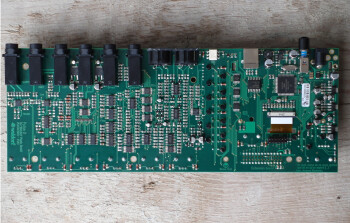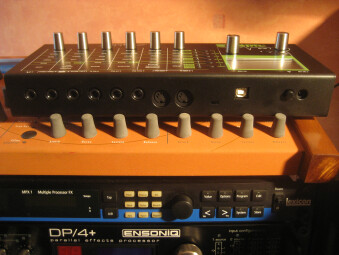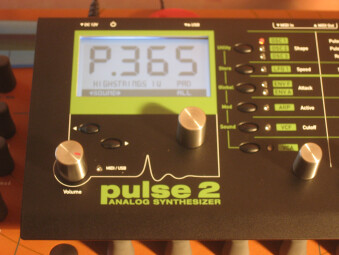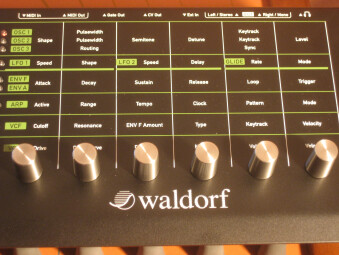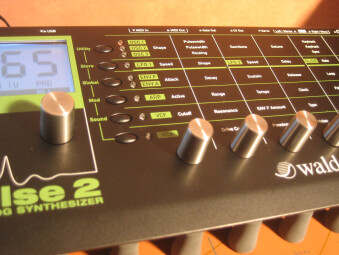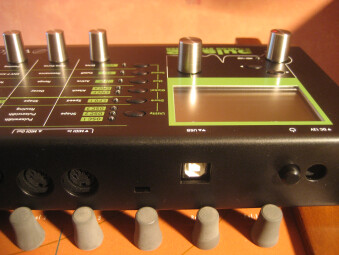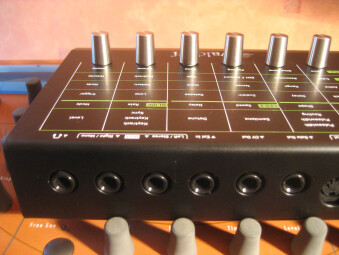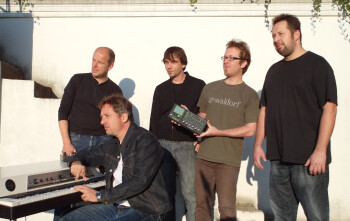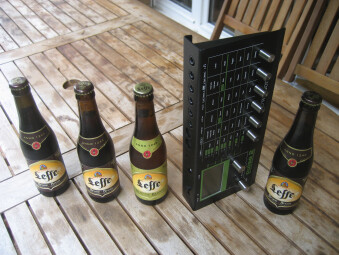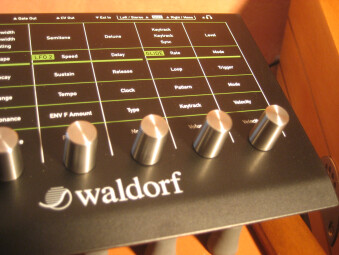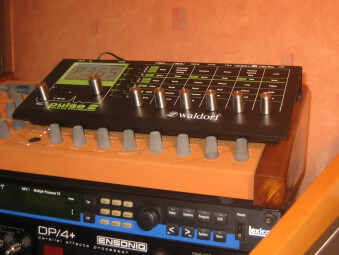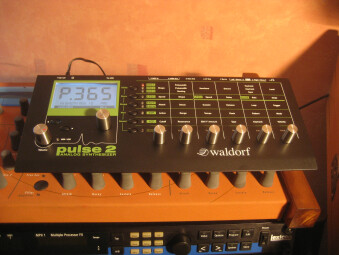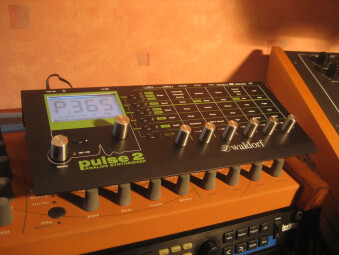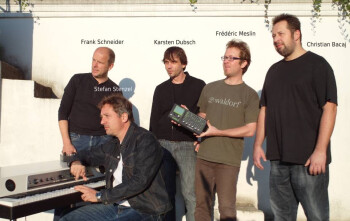Introduced in Frankfurt 2013 in its almost final version, Pulse 2 marks the return of Waldorf to its analog passions. The brand recently lent us one, just when its first commercial models are hitting the market... gulp!
During Frankfurt 2012, Waldorf showcased a demo of Pulse 2. But it wasn’t until 2013 that we could actually hear a functional, even though not final, version. Some among us almost lost both our ears (and part of what’s between them) because the boisterous little monster had a tendency to increase the decibels in an uncontrolled manner when changing programs. But those days are long gone… today we can play with a finished machine running a freshly installed OS 1.11. With this Pulse 2, Waldorf — after Korg and Novation, shaken up by Arturia’s MiniBrute — has returned to its analog passions, for our great pleasure. 17 years after the first Pulse / Pulse+, let’s see what our little friend hides on the inside…
The French touch
The Pulse 2 is very small. Sporting a black metallic shell with green letters, it follows the same basic form of the Blofeld module. The control panel couldn’t be more explicit: on the left we have a 128 × 64 point LCD with adjustable contrast that displays the programs and parameters currently being edited (but not the value stored). Beneath it we have two edit/select buttons, a volume knob and a detented edit/select encoder. To the right we have the large sound editing matrix with inscribed parameters grouped in synthesis sections. The matrix features six buttons (for nine lines) and six encoders (for six columns). The rotary encoders feel firm and not loose at the shaft, even if the controls are not screwed to the chassis. All in all, they inspire confidence. They look pretty classy with a glossy stainless steel cap that gives them a nice effect. The color combination is a matter of taste — if you are not happy with it complain to Axel Hartmann!
On the rear panel we have the (pertinently selected) connections: power switch and inlet (universal PSU with interchangeable adapters, which we will need to get used to …), USB port, Kensington security slot, MIDI In / Out, CV/Gate outputs (thank you!), audio input (thank you, thank you, thank you!), stereo outputs, and headphones output. All jacks are 1/4" and there’s no awful mini-jack in sight. On the inside everything is on one single circuit board that fills all the space. Components are surface-mounted on the bottom, so everything can be accessed immediately — clever, guys! The screen and pots are the only thing mounted on the upper side, otherwise we wouldn’t be able to use them — really clever, guys! Looking at the PCB image, the keenest among you will surely have noticed a phrase taken from Jean-Jacques Rousseau’s New Heloise: “On jouit moins de ce qu’on obtient que de ce qu’on espère” (We take less pleasure in that which we obtain than in that which we await). Frédéric Meslin, French hardware engineer who worked on the Pulse 2, will explain himself at the end of this review…
Exemplary usability and design
The Pulse 2 is an example of usability in a reduced space.
All controls are accessible on the panel with a very well-accomplished matrix: we select the sections directly (oscillators, LFO, envelopes, VCF, VCA…) and can edit up to six parameters with the encoders, without any value drops. They are good-sized and well-spaced and offer a perfect resistance, besides being sensitive to rotation speed, which allows us to make quick and accurate edits over wide ranges. There’s no better type of encoder for editing and Waldorf has accustomed us to them for a long time. A (curiously unlabeled) Shift button allows us to access additional options via the menu, like compare, recall, initialize, and, dump sound(s), global reset, transpose, MIDI parameters, CV/Gate modes, filter auto-tune, LCD adjustment, audio input gain, modulation matrix… The latter completes the direct synthesis settings per program and is visible all on one page, which is super practical to edit.
The 500 programs loop in both directions and can be recalled by category. When we edit a parameter, “E” is displayed instead of “P.” Modifications are kept even if you change programs, as long as you don’t turn off the synth or use the Recall function. To save the changes, you simply have to press Store… More than 400 programs comprise the editable factory sounds, which we are about to discover.
What a sound!
The Pulse 2 is a mono analog synth capable of operating in eight-voice paraphonic mode, as we will see later on. All audio is analog, even though modulations are digital, which provides a fat sound character, a good stability and the possibility to go crazy with the signal in very complex ways — in real time. Right from the start the sound we hear is very pleasant: deep, resonant, punchy, dense bass sounds; leads ranging from the cleanest sawtooth filtered in a vintage way to the most extreme and wicked distortions. In the first case we appreciate being able to input a warm signal into the filter with a slight analog distortion. In the second case, it’s the output’s symmetrical distortion that is driven to excess that young ears will appreciate.
Fans of oscillator sync are well served and they will learn with delight that the Pulse 2 doesn’t generate digital artifacts when we push the frequencies upwards. Vocal formants indicate, both the presence of oscillators capable of intermodulation and sophisticated filtering. We appreciate the different filter slopes in low-pass mode, as well as the other types of response (high-pass and bandpass). Synthetic percussions immediately reassure us of the envelope’s trigger, as do the special effects of the complex modulation possibilities. Factory programs are really good. The quality of the programming team credited in the brief Getting Started supplied with the synth (the 73-page V1.0 manual can be downloaded in English and German from the manufacturer’s website) is obvious).

- Pulse 2 001 00:48
- Pulse 2 002 00:29
- Pulse 2 003 00:27
- Pulse 2 005 00:21
- Pulse 2 009 00:17
- Pulse 2 010 00:36
- Pulse 2 011 00:29
- Pulse 2 012 00:36
- Pulse 2 017 00:36
- Pulse 2 018 00:45
- Pulse 2 021 00:39
- Pulse 2 023 00:17
- Pulse 2 033 00:36
- Pulse 2 040 00:18
- Pulse 2 057 00:13
- Pulse 2 080 00:22
- Pulse 2 102 00:26
- Pulse 2 113 00:50
- Pulse 2 142 00:33
- Pulse 2 231 00:22
- Pulse 2 232 00:15
- Pulse 2 254 00:34
- Pulse 2 028029030 00:17
Colossal oscillators
The Pulse 2 is even more generous than the Pulse in terms of oscillators. Just like the first version, it features three DCOs, but it goes much further, as we are about to see.
The three DCOs are not identical, starting with the waveforms: sawtooth and triangle for all three DCOs, variable pulse for DCO 1 and 2, fixed square for DCO3 and APW (constant-energy pulse with a subharmonic one octave below) for DCO1. But the Pulse 2 really outshines the Pulse with its new waveforms, which are somewhat exotic when it comes to analog synthesis: unison, paraphonic and X-PWM. UNISON M creates a monophonic unison based on eight pulses, with controllable detuning. The sound is very fat! UNISON P uses the same eight pulses in polyphonic mode, allocated this time according to the number of notes played: one note = eight detuned pulses; two notes = four detuned pulses per note, etc. The UNIAPW M and UNIAPW P modes work in a similar way, but with APW (see below).
Now it’s the turn of the paraphonic modes: PARA-8 allows us to play eight-note chords with one single pulse per note, without unison this time; the Keytrack parameter controls the fading of the pulse-width modulation, where the rate also depends on the amplifier envelope’s Attack and Release. In PARA-4 mode, polyphony decreases to four voices but we can use two tuned pulses as we please (two four-voice paraphonic DCOs). By the way, do not forget what paraphonic means: all eight voices pass through one single VCF and one single VCA, and thus they are all modulated simultaneously, as opposed to a polyphonic analog synth that uses as many VCFs and VCAs as voices it has.
Finally, the X-PWM modes create a ring modulation between DCO 2 and 3 or 2 and 1. In short, you can amuse yourself to death with what the oscillators have to offer. We can replace the signal of DCO3 with an external audio signal; the amplitude envelope must be triggered by a note played on its own or as an arpeggio to hear the result. DCO3 can also create a feedback loop between the VCA’s output distortion (see below) and the source mixer input; it creates a supplementary resonance peak. Even better, it can modulate the amplitude of DCO2, the filter frequency or the distortion circuit, with adjustable and controllable amount. It’s frankly excellent to have such possibilities while remaining in the analog realm! We can obviously configure (and modulate) the pulse-width of DCO 1 and 2, tune all three DCOs (+ or – 48 semitones) and fine detune them (+ or – 1/64th of a semitone). Keytrack on DCO 1 and 2 can also be deactivated to create formants that are modulated by DCO3. DCO2 can be synced to DCO3 (very active indeed) to create very interesting sweeping or arpeggio effects. The three DCOs (and eventually the external signal) go then to a mixer where they join the pink noise generator. Volumes can be adjusted and modulated individually. As soon as we push the level up we create a very natural and pleasant saturation.
VCF & VCA
The output of the mixer goes to a high-quality multimode resonant VCF. It can operate in LP24, LP12, BP12 and HP12 modes. You can really feel the slope difference between LP 24 dB and 12 dB. The BP mode is very effective and allows us to create guttural internal resonances. The high-pass mode allows interesting zapping effects, combined with a fast envelope. The cut-off frequency can be directly modulated by a dedicated envelope, keytrack (0% to 200%) and the velocity, everything with bipolar action, thank you! The resonance does not overshadow the adjacent frequencies when we push it way up. It goes all the way into self-oscillation in all modes, where it then generates a pure sine wave that we can tune with the frequency and make it follow the keyboard pretty accurately. The manual recommends us to tune the filter frequently with a function available in the Utility menu. Pure Analog Land…
The VCF output is injected into the final VCA. The signal can then pass through an analog distortion with gain control and one of two choices of saturation: Tube (a vintage-type warm and sweet asymmetric distortion) and Fuzz (a very aggressive symmetric distortion). Everything goes then through a panorama that can be modulated before going out of the Pulse 2 for good. The final volume can be modulated by a dedicated envelope and the attack velocity, everything in a bipolar way. Cool. Oddly enough, it is in the VCA where we find the noise generator’s volume setting.
Matrix modulations
Like all Waldorf machines with digital control, the Pulse 2 excels when it comes to modulations. Starting with two LFOs whose speed can vary more than four minutes at 100 Hz (audio level). It’s fast, but less than the 261.6 Hz (C3) of the original Pulse. The frequency of LFO1 can be synced to the MIDI clock according to different tempo divisions (32 to 1/96th of a note). On LFO1, we can choose the waveform (sine, triangle, sawtooth, square, and random). For its part, LFO2 is a simple vibrato with a triangle wave. But, on the other hand, it has a programmable delay, which LFO1 doesn’t have (directly; see modulation matrix below). It lacks LFO retriggering modes to be exhaustive.
The two envelopes are ADSR. They are pre-assigned to the VCF and VCA but can also be assigned to other destinations via the matrix. We really like their quickness and their different triggering modes: free, simple trigger from the start, simple trigger at current value, retrigger from the start, retrigger at current value, and forced up to the end. Envelopes can be looped: A-D mode loops between the two eponymous segments, while D-D mode loops alternatively between the envelope’s maximum and minimum values at the speed of the decay, sweet!
One of the biggest assets of the Pulse 2 is, without a doubt, its 24 × 30 modulation matrix with eight slots and bipolar modulations. Among the sources are: LFO1 (directly or modulated by the wheel or aftertouch), LFO2 (directly or modulated by the amp envelope), the two envelopes, velocity, keytrack (with or without portamento), the wheels, pressure, an assignable CC, release velocity, and six combined modulations, to which we will come later. Among the targets we have: global pitch or that of either oscillator, PWM, levels, noise, filter cut-off, resonance, volume, pan, LFO1, drive, Glide rate, the envelopes’ rates, unison detuning, the fade out of the VCA in paraphonic mode, the arpeggiator’s swing, CV Out, and the six combined modulations. The latter allow you to do mathematical operations using one or several sources: sum, multiply, delay, low-pass filter, min, max. After assigning one or several sources to its targets, we end up with another modulation as a new source. Very nice! Finally, a Glide generator with variable rate and different response modes (legato, triggered and released notes) is also available. Phew!
Programmable arppegiator
The Pulse 2 wouldn’t be a Waldorf if it didn’t have a well-thought-out arpeggiator. Having 16 steps, it is stored within each program. We can adjust the global step length (12% to 1600% of the clock), the swing (0% to 100%, 50% being the no-swing setting), the global delay in relation to the clock (forward/ backward), the number of steps (1 to 16), the modulation source controlling the accent (same as for the matrix). Each step can be edited according to three parameters with a menu page that displays the settings graphically. We begin with the type of event: OFF, SOFT (accent), NORM(al accent), HARD (accent), EVEN (cycles only), ODD (cycles only), OCT+ (one octave above the note played), 1ST (only the first note is played), or RESET (plays from the start again). Then we have the individual step length in relation to the global length (25%, 50%, 75%, 100%). And finally Glide, that allows us to link the note to that of the previous step.
In order not to start from scratch, we can copy a motif from another program. Once the motif has been programmed, it can be played in different ways: up, down, alternate, or random. The first three modes can be limited to the first 16 notes played. The arpeggiator can be deactivated, activated and put on hold (adding notes to the sequence). It is capable of operating from 1 to 10 octaves(!) and it can be synced to the MIDI clock (1 to 1/96th of a note). We can activate MIDI note send and receive for it to sync perfectly with the outside world, either as master or slave. A very nice achievement that ought to inspire other manufacturers, even on larger devices!
Intimate conversations
The Pulse 2 features connections that allow it to communicate with external devices of any generation: CV/Gate, MIDI and USB. With the MIDI In or USB, the Pulse 2 can receive all sorts of MIDI data: notes, CC / Sysex (which means automation), programs, and OS updates. A small LED flickers as soon as MIDI / USB data is received, cute. Conversely, the MIDI Out and USB can also be used to send the same data, except for the OS updates, obviously. The MIDI Out can also work as a MIDI Thru.
The Pulse 2 is backwards compatible with the Pulse, both at a control (Legacy mode) and program (dump via Sysex) level. The Pulse 2 works in CC, CC + Sysex or Sysex mode, each of which has its pros and cons: CCs are not enough to manage all parameters, but they are super simple to edit with all sequencers; Sysex are comprehensive but a pain to edit; and, finally CC + Sysex mode is the best compromise. While we can only control a maximum of 128 values per parameter directly and with MIDI, internal resolution is 15 bits minimum with smoothing afterwards; we can perceive very slightly the filter’s cut-off with slow direct settings, but less so with faster settings.
We asked Waldorf if certain parameters could benefit from a finer resolution with the encoders or MIDI (for example with 14 bits like a Moog): it depends on the return of the clients, knowing that the maximum resolution is preserved via the modulation matrix. This problem doesn’t exist with the CV/Gate outputs that we can use to control pure analog synths. They actually feature a 14-bit DAC to convert the digital modulations into CV. CV works in Volt/Octave or Hertz/Volt, which allows us to work with most antiques. CV transmits Pitch (notes + arpeggiated notes, awesome!), a unipolar voltage (useful, for example, for a modulation created from an envelope) or a bipolar voltage (modulation stemming from an LFO). The output voltage can be adjusted for both the CV (slope + fixed voltage) and the Gate (0 or 3.3 V polarity). Thus, the Pulse 2 does the job of a MIDI – CV/Gate interface for the same price, bravo!
Heart for sale
The Pulse 2 carries on the tradition of the first Pulse, from where it takes a great deal of the architecture to which it adds improvements and modern functionalities: a multimode filter, a real display, automation of all parameters, USB… and everything while still being compatible with its ancestor. Better yet, it adds unison and paraphonic modes to extend significantly the sound palette. Playing with it or reading the tricks in the user manual we get the impression that the synthesis was conceived by analog synthesis experts for analog synthesis freaks. Apart from the resolution, which is a bit low for certain parameters (128 values), the Waldorf team has achieved a virtually faultless synth, in terms of sound, usability and features. With its very reasonable price tag, the Pulse 2 should be considered very seriously, regardless of whether you are an expert or a newbie, a studio or a live musician. As far as we are concerned, it has earned the Safe Bet Award 2013!
Download the audio files (in FLAC format)
Interviews with the creators
Stefan Stenzel, software engineer and boss at Waldorf Music
AF: What’s your background?
Stefan: I started working as a programmer at Waldorf in 1991, so excited at the opportunity of creating synthesizers that I didn’t hesitate to quit my tedious computer science studies. In 2006, I had the pleasure of being part of a group of very motivated persons that decided to carry on with Waldorf after a brief break of approximately three years.
AF: You have gone through different periods – good and bad – since the creation of the Waldorf brand 25 years ago. What can you tell us about that?
Stefan: To begin with, I would like to point out again that I wasn’t among the founders of Waldorf Electronics Gmbh in 1988. I started in 1991. We have certainly had highs and lows, but nothing special that has ever made me regret my decision to create synths.
AF: What were the guidelines during the conception of the Pulse 2?
Stefan: We knew that the original 1995 Pulse had always been very sought-after, so our first goal was to make the Pulse 2 compatible in terms of sound. But to stop there wouldn’t have been very interesting, so we added different filter modes, distortion circuits, routings of the third oscillator towards different control voltages, and the paraphonic modes with eight oscillators to offer a greater flexibility. I think the end result is an analog synth that is easy to use.
AF: How did you put together the development team?
Stefan: Slowly. In the beginning we signed a contract with a company for them to make hardware blueprints and the general architecture from my personal notes, but we discovered too late that the work delivered wasn’t up to our standards. Later on we hired a very talented young engineer, Frédéric Meslin, who redid the entire hardware development from scratch. He also took part in the software development and coordinated the beta tests.
AF: What were the main difficulties you had? And how did you overcome them?
Stefan: The problem with analog synths is to guarantee that each unit sounds exactly the same as the others, at least with a certain degree of similarity. We meticulously chose high-quality components, but they don’t match enough to avoid having to make fine adjustments with every voltage control. To get optimal results, we introduced a digital circuit that allowed us to do different measurements and automatic adjustments during production. This circuit is also used for the filter tuning procedure available to the user with the current OS.
AF: Are there any OS improvements on the agenda for the Pulse 2?
Stefan: Yes, even though the oscillators are analog, the circuit is flexible up to the point that we could add more waveforms without the need of any physical modifications. And we also listen to the improvement proposals and demands of the users.
AF: Can you tell us anything about any future product developments? A Pulse 2 in keyboard format?
Stefan: No news for the moment, but stay tuned to the new products and announcement at the NAMM…
Frédéric Meslin, hardware engineer
AF: How did you start working at Waldorf?
Frédéric: I am a self-taught software developer and I subsequently got a degree in Electronics and Computer Engineering at INSA-Rennes (France). I had always been interested in electronic music for video game projects. My job is to experiment with new technologies and develop products at Waldorf. I am mainly involved in the conception of circuit boards, but also in the software development (integrated and for computers). I wasn’t involved in the initial development of the Pulse 2 synthesizer. Stefan Stenzel and Thorsten Feuerherdt (of Manikin Electronic) were responsible for the technical decisions at Waldorf Music before I came in. The original Pulse blueprints served as our starting point but we then extended them to be able to offer all the new functionalities of the Pulse 2. My first job was to analyze the different prototype versions produced in order to create an industrial product that complied with our quality and price expectations and adapted to the know-how of our partner factory. This stage required a redesign of the whole electronics section.
AF: What technologies did you use to create the different waveforms of the oscillators?
Frédéric: In synth jargon, we have DCOs with the exact same structure as on the original Pulse. Their principle is the following: we charge/discharge a condenser with the help of a constant current (proportional to the desired frequency) and a clock signal periodically reinitializes the charge. That way we can produce the common waveforms: triangle, sawtooth or PWM. This technique, used in many analog instruments, guarantees a substantial frequency range for the oscillators, avoids any aliasing with regard to modulations at audible frequencies and guarantees a reproducible stability in terms of frequency that provides certain comfort when working. So it is no longer necessary to retune the synth every other day because the tuning does not correspond to that of the recordings of the day before.
AF: How did you conceive the different filters?
Frédéric: The filter section is based around a transistor ladder structure, modified in order to produce the different responses: LP24, LP12, BP12, HP12.
AF: How do the unison and paraphonic modes work, technically speaking?
Frédéric: From a hardware point of view, the classic oscillators are deactivated and we use the control signals to generate eight PWM oscillators in order to produce the voices necessary for these polyphonic modes.
AF: How do the X-PWM modes work, technically speaking?
Frédéric: The X-PWM modes can be compared to a ring modulator. An XOR type of operation is applied to the control signal. With this mode we can add non-harmonic frequencies to the fundamental frequencies of the oscillators. Which is very practical for metallic, bell sounds.
AF: What were the main difficulties you had while developing the Pulse 2? And how did you overcome them?
Frédéric: The Pulse 2 is my first real project. Two years earlier, I was very modestly involved in the software development for Arturia’s MiniBrute, but I was not responsible for the design. This time it was different. There’s a huge difference between what you can do at home and what is required for an industrial project. The hardest part was to take over a product already in development and being able to meet our users’ expectations. And we had to respect Waldorf’s philosophy when re-designing the project as well. Generally speaking, I’d say we needed a lot of patience, perseverance and logic to overcome the engineering difficulties. Plus a good sense of humor and dynamism!
AF: Why did you quote Rousseau on the circuit board?
Frédéric: Among the not-so-many philosophers I was able to read during my schooling, Jean-Jacques Rousseau is one of the few that marked me, for his independence and the sharpness of his analysis of contemporary society. We received a lot of emails from users that just couldn’t wait for the Pulse 2 to come out. We really appreciate the interest on our instruments but it also reminds us of the time that goes by. In Julie or The New Heloise, Rousseau explains that what makes our desire more pleasurable is the awaiting of the object, not the satisfaction of the desire itself. Children know this better than anyone, especially when Christmas comes. Perhaps it is a bit early, but we hope there will be several Pulse 2 under the tree!



